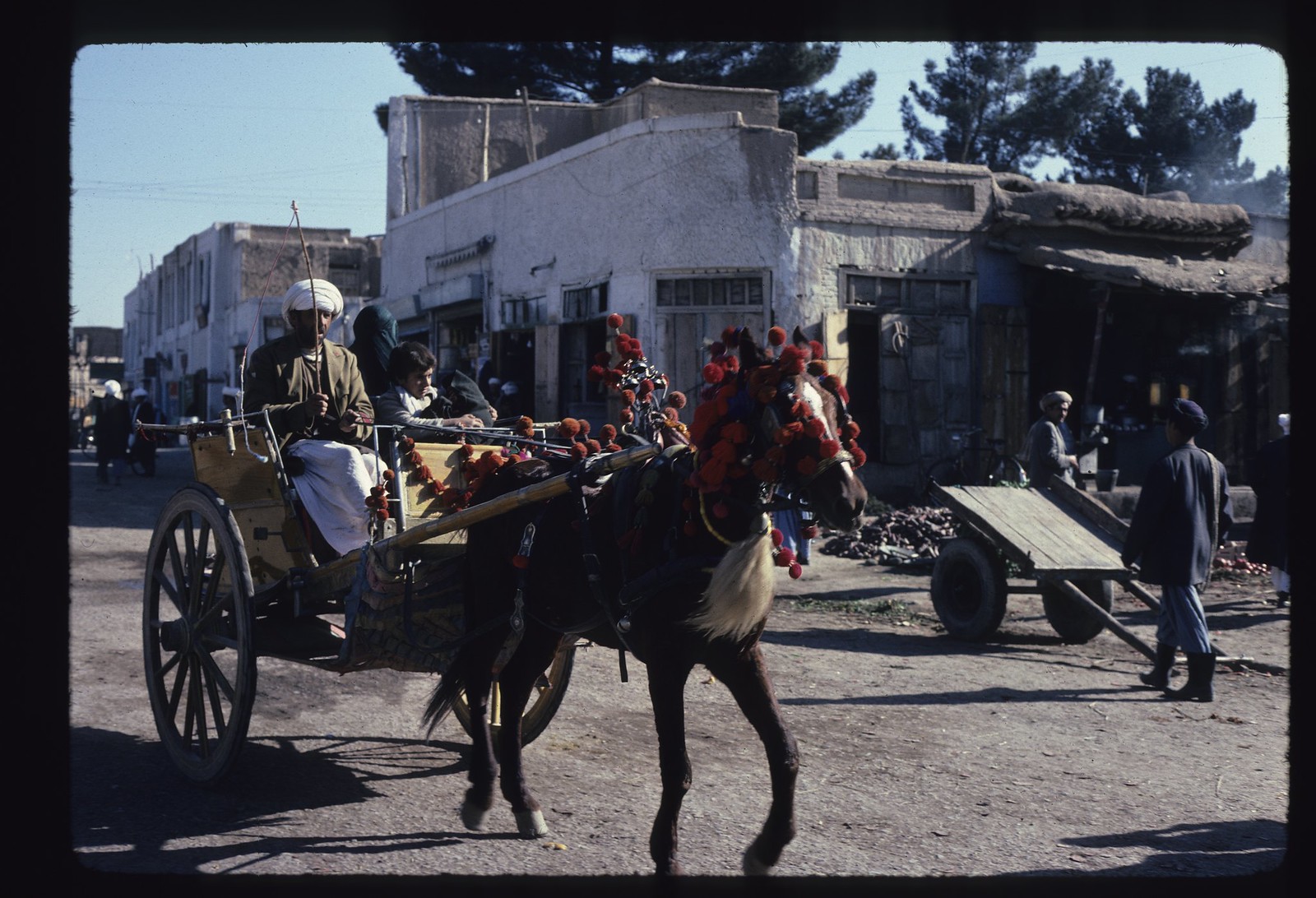Selected photos from the book Afghanistan Before the Rain of Fire, Text and photographs by Chris Lowry
Canon AE-1 camera, Kodachrome slide film. Lenses 50 mm, 28 mm and 135 mm telephoto.
(You can read the Prologue essay below)
These photographs were shot on a solo overland trip to India from Europe in the autumn of 1977. No one knew it yet, but it was the end of a sixty-year run of unbroken peace in Afghanistan. In April of 1978 there would be a military coup. A group of local Marxists, much to the dismay of Moscow and most Afghans, would assassinate the president, take over the country and suddenly attempt to radically change relations between peasants and landowners, men and women. For the hippies on the Magic Bus travelling overland from Amsterdam toward the beaches of south India, there was no hint of that in the air. Roadside flowers and jingling bells on horse-drawn buggies gave the sense, to a foreigner, of being caught in a gentle medieval time warp.
Sixty years of peace, in a country that had been soaked in bloodshed for millennia. When the Russians began their occupation of the country in 1979, the people of Afghanistan had not been conquered or colonized since the decline of the Moghul Empire in the 1600s. During those three centuries, every Afghan ruler was either deposed or assassinated. President Daoud, assassinated in 1978, had also come to power in a coup.
Afghanistan was a crossroads for empires, tribal rivalries and the riches of the Orient. Alexander the Great, Ghengis Khan and Babur all tried to tame it. Some say that the blue eyes among the mountain peoples came from Alexander’s Greek soldiers. The land is strategically important and resource rich, yet virtually unconquerable. The only near-universal trait common to all Afghans is a fierce territoriality rooted in feudal, clan and ethnic loyalties, nurtured in communities isolated by mountainous terrain. Even Islam is not unified among Afghans, as Sunni and Shi’a versions of truth face off across mountain passes with mistrust and mutual contempt.
The region was prize, a buffer zone in the Great Game played by the imperial powers of Britain and Russia. During the course of three bitter Anglo-Afghan wars, the British learned a lot about Afghan vengeance. The mountain passes east of Kabul offered many Englishmen their last glimpse of hell on earth, as when Sir William Elphinstone’s retinue of 16,500 were slaughtered without mercy in the winter snows as they tried to retreat from Kabul across the Khyber Pass in 1842.
Since the signing of the end of the third Anglo-Afghan War and the signing of the Treaty of Rawalpindi with Britain in 1919 ending, foreigners had stopped trying to conquer this region. From his urban base, King Amanullah Khan made efforts to move the country into the 20th century, but in the rugged, roadless provinces traditional life changed little from one century to the next. After World War II it became a chessboard for the Soviets and the Americans. The CIA begain working in Afghanistan forty years before they backed the mujahidin against the Russians. James A. Michener, who was there in ’46, called it “an exciting, violent, provocative place… one of the world’s great cauldrons.”
By 1977 there were cars, trucks and TVs, but nine out of ten Afghans were not literate and lived, both culturally and geographically, beyond the reach of modernity.The fall of ’77 was a delightful time to be in Afghanistan with a camera. I was twenty-two years old. I wandered through central Asia trying to be like my photographer hero, Henri Cartier-Bresson, in search of the decisive moment. I walked around with a camera on my hip. My favorite lens was a 135 mm telephoto. I didn’t always ask permission, but when I did, it was never refused. Many of the portraits and images of daily life were taken quickly while walking through a marketplace, far enough away that the subject does not notice me and doesn’t react to the camera.
The photos are impressionistic, culturally ignorant, seeing everything for the first time, through the lens of my monkey curiosity. I did slow down to sit in courtyard gardens, to play guitar and drink tea and smoke with other travelers. But I was restlessly moving, fascinated by the new, with other destinations in mind—beaches, riverboats, holy sites, festivals, mountain trekking. It was early December, and I planned to spend Christmas in Delhi.
I have tried to write about these photographs so many times, it has become a joke I tell myself. “I’m writing that Afghan photo essay.” But each time I tried to make sense of what had happened in Afghanistan at my second-hand distance from the horrors of the Russian war, the Taliban and Operation Enduring Freedom, my photos seemed dated, nostalgic, eclipsed by history. When the wars started I wondered how many of the people in my pictures had been killed. The Afghan photo essay settled in my heart like a guilty secret. My Afghanistan has suffered death by a thousand cuts.
I settled back in Canada, became a film maker, got married and began to raise a family, but I never forgot Afghanistan. I worked in international development for several years, and had friends who worked on peace-building among the Afghans. I focused on kids affected by war. Friends made films about the Afghan conflict. In her psychology practice my wife treated military personnel who suffered from PTSD. One of our sons’ babysitters, Lyly, served in Afghanistan with the Canadian Forces.
We see what we want to see, what we look for. In 1977 I travelled in a state of half-informed curiosity, unaware of the political unrest beneath the picturesque surface, mindful of the intricate web of custom that separated me from the local people, unaware of the political unrest beneath the picturesque surface. These are a foreigner’s naïve impressions of everyday life almost forty years ago, when Afghanistan was at peace.

